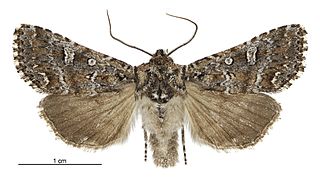
Ichneutica lithias is a moth of the family Noctuidae. This species is endemic to New Zealand. It is a small moth but distinctive as a result of the markings on its forewings. Although this species is widespread in the South Island, it has only been collected in the Rangipo Desert in the North Island. The species prefers habitat that is scrubland ranging in altitude from coastal to alpine. Adults are on the wing from October to April and larvae have been collected and reared on the New Zealand endemic plant species Melicytus alpinus.
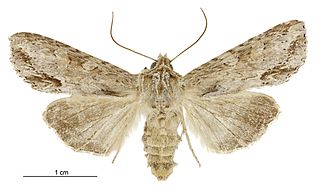
Ichneutica mollis is a moth of the family Noctuidae. It is endemic to New Zealand and is found from the Coromandel peninsular and Mount Te Aroha southwards including in the South and Stewart Islands. It lives in a variety of habitats including mountainous beech forest, podocarp forest and also grasslands. The larvae feed on grasses and herbs. The adults of this species are on the wing from October to March and are attracted to light and feed on blossoms.
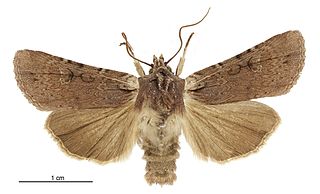
Ichneutica omoplaca is a moth of the family Noctuidae. It is endemic to New Zealand. It is widespread from the Bay of Plenty in the North Island down to Southland in the South Island. Specimens have also been collected from the Auckland Islands. It lives in a variety of habitats including beech forest clearings and tussock grasslands. This species has been recorded that some of the larval hosts of this species include Poa cita, Dactylis glomerata and it has been reared on Plantago lanceolata. The larva is undescribed but pupae have been found in a pine plantation in soil under weeds. Adults of this species are on the wing from October to March. The adult moths are variable in appearance but the diagnostic feature is the pale ochreous to white colouring between the basal streak and the costa which contrasts with the ground colour of the forewing.

Ichneutica pelanodes is a moth of the family Noctuidae. It is endemic to New Zealand and has been found in scattered locations in the North, South and Stewart Islands. I. pelanodes is easily confused with I. skelloni as the two species are visually extremely similar. In the North Island though the range of the two species appears not to overlap. Generally of the two species I. pelanodes tends to be darker in appearance. I. pelanodes inhabits wetlands but the life history of this species is unknown as are the host species of its larvae. Adults are on the wing from October to February and are attracted both to sugar and light traps.
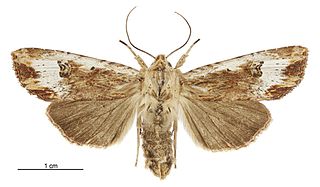
Ichneutica rubescens is a moth of the family Noctuidae. It is endemic to New Zealand. This species can be found locally in the North Island but is widespread throughout the South Island and is present on both Stewart Island and the Auckland Islands. I. rubescens has a round or oval mark near the centre of the forewing that encloses a dot. This is diagnostic of this species. I. rubescens inhabits tussock grasslands, beech as well as podocarp forests. Larval hosts are likely herbaceous plants such as grasses and herbs and larvae have been reared on Gunnera prorepens. Adults of this species are on the wing from December to April and are attracted to light.
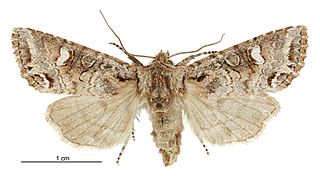
Ichneutica sericata is a moth of the family Noctuidae. It is endemic to New Zealand. This species is variable and difficult to distinguish from I. skelloni specimens. It is known from the southern part of the South Island and from Stewart Island. There has been one specimen collected in Taranaki but although Robert Hoare determined the species, he expressed reservations given the location of collection. I. sercata inhabits shrubland at altitudes of between 470 and 900m. The life history of this species is unknown as are the host species of its larvae. The adults of this species are on the wing in August at Stewart Island and in November and December in the South Island.

Ichneutica blenheimensis is a species of moth in the family Noctuidae. It is endemic to New Zealand and is found throughout the North, South and the Stewart Islands. This species appears to prefer drier eastern localities and is rarely collected in western North Island forested areas. It does not appear to be frequently collected in inland dry tussock grassland habitats. The host plant for the larvae of this species is likely to be the golden sand sedge pīngao which is now absent from the moths type locality. However Chappell has raised very young larvae on grass species and the more developed larvae consumed Phormium tenax. Adults are on the wing from November to March and are attracted to both light and sugar traps. The blackish forewing fringes are diagnostic of this species. But worn specimens of I. arotis can be confused with worn specimens of I. blenheimensis. However I. arotis can be distinguished from I. blenheimensis as it has a scale-tuft on the thorax and dark longitudinal stripes on the tegula. This species is classified as "At Risk, Naturally Uncommon" by the Department of Conservation.

Ichneutica steropastis, or the flax notcher moth, is a species of moth in the family Noctuidae. It is endemic to New Zealand and can be found throughout the country from the Three Kings Islands to Stewart Island as well as in the Chatham Islands. The larvae of this species feed on a variety of native and introduced plants however the New Zealand flax is one of the more well known host plants for the larvae of this moth. The larvae are nocturnal, hiding away in the base of the plants and coming out to feed at night. They create a distinctive notch in the leaf when they feed. The adults of this species are on the wing from October to March. Although adult specimens of I. steropastis are relatively easy to recognise they might possibly be confused with I. inscripta, I. theobroma or with darker forms of I. arotis. However I. steropastis can be distinguished as it has a long dark basal forewing streak that these three species lack.

Ichneutica averilla is a moth of the family Noctuidae. It is endemic to New Zealand. This species is found in the North Island at Mount Taranaki but is widespread throughout the South Island and Stewart Island. It prefers mountainous habitat but can be found down to sea level in the southern parts of the South Island. Adults of the species are on the wing between November and March. Larvae likely exist on a variety of herbaceous plants but have been recorded as feeding on species within the genus Plantago. This species is sometimes confused with I. mutas but can be distinguished from the latter on the basis of forewing colour as well as the absence of or an indistinct antemedian forewing line.
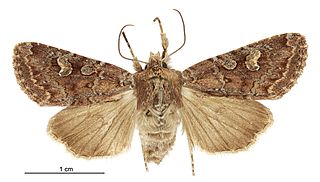
Ichneutica agorastis is a moth of the family Noctuidae. This species is endemic to New Zealand. This moth is similar in appearance to two other species in the genus but can be distinguished through the colour and size of its forewings. This species is found in the South Island and Stewart Island in open habitats in the subalpine zone. However, in Southland I. agorastis can be found down to sea-level. Adult moths are on the wing between January and April. The life history and host species are unknown.

Austramathes squaliolus is a species of moth in the family Noctuidae. It is endemic to New Zealand and is found only in the Chatham Islands on the Chatham, Pitt, Little Mangere and Rangatira Islands. The larvae of A. squaliolus is similarly patterned to the larvae of A. fortis and have lateral yellow markings that contrast with the dark dorsal marbling. However this marbling is darker in A. squaliolus in comparison to the lighter coloured A. fortis. Melicytus chathamicus is the larval host-plant for this species. The adult moth is again very similar in appearance to A. fortis and, as with A. fortis, the black line curved at the forewing base is the distinguishing feature. However the two species are unlikely to be confused as their ranges do not overlap. The adult moths are on the wing in November and December and have been observed flying at dusk.

Ichneutica panda is a species of moth in the family Noctuidae. It is endemic to New Zealand and only found in central and southern parts of the South Island. The species has not been collected in Canterbury since the late 1950s and has not been seen at The Wilderness scientific reserve since 1941. This species is similar in appearance to Ichneutica falsidica however I. panda lack or have indistinct black dashes on their edge of their hindwings. I. panda inhabit shrubland from alpine zones down to river terraces and adults are on the wing between December and February. The life history of this species is unknown as is the host species of the larvae.

Ichneutica chryserythra is a moth of the family Noctuidae. Living specimens have distinctive violet red coloured forewings but can be distinguished from the similar species Ichneutica marmorata as it lacks the dark edge markings of the later species. I. chryserythra can only be found in the southern parts of the South Island. Adults are on the wing between November and January. The life history of the species and the host species of its larvae are unknown.
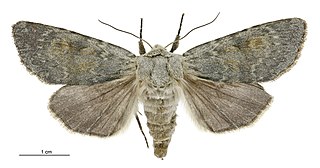
Ichneutica nobilia is a moth of the family Noctuidae. This species is endemic to New Zealand and can be found in the South Island, although not in the Nelson, Dunedin or Southland regions. This species prefers rocky habitats in alpine zones and the blueish-grey sheen on the species' forewings help camouflage it. Adults of I. nobilia are on the wing from December to February and are attracted to light. The life history of this species is unknown as are the host species of its larvae.
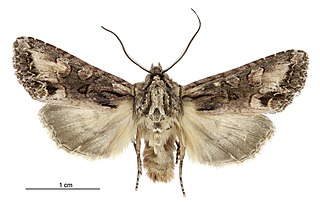
Ichneutica bromias is a moth of the family Noctuidae. This species is endemic to the Chatham Islands of New Zealand where is found on the Chatham, Pitt and Rangatira Islands. This species is similar in appearance to Ichneutica mutans but is darker and duller in its overall appearance. However, as I. mutans is not present in the Chathams this similarity is unlikely to cause confusion. The adults of the species are on the wing from November to March. The life history and the larval host species are unknown.

Ichneutica erebia is a moth of the family Noctuidae. This species is endemic to New Zealand and is found on Campbell Island and the Auckland Islands. Adults of this species are on the wing from August to January. The adults are variable in appearance but can be distinguished from similar species by the patters or lack thereof on their forewings. The larvae of I. erebia are polyphagous and hosts include Pleurophyllum criniferum, species within the genera Stilbocarpa and Carex, as well as Chionochloa antarctica, Urtica australis and Raukaua simplex.
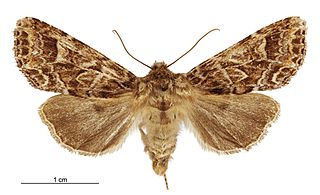
Ichneutica brunneosa is a moth of the family Noctuidae. This species is endemic to New Zealand. It can be found in the North Island from Mount Te Aroha and in the South Island from the Coromandel to Stewart Island. However it appears to not be present in the centre of the South Island. The distinctive colour and patterns on the forewing of this species ensures it is unlikely to be confused with similar species. It inhabits native forests with higher rainfall and is attracted to mercury vapour light traps. The life history of I. brunneosa is unknown as are the host species of its larvae but the adults of the species are on the wing from October to January.
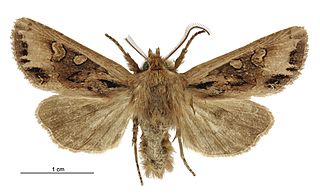
Ichneutica fenwicki is a moth of the family Noctuidae. This species is endemic to New Zealand and is found in the southern parts of the South Island and on Stewart Island. It is a distinctively coloured moth that is unlikely to be confused with closely related species. It is a spring flying moth being on the wing from September to November. The life history and host species of the larvae of I. fenwicki are unknown.
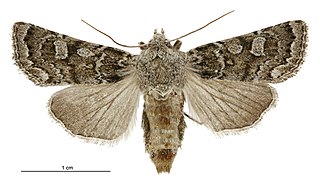
Ichneutica sistens is a moth of the family Noctuidae. This species is endemic to New Zealand. It can be found in the central North Island and throughout the South Island, although it is more common on the eastern side of that latter Island. It is very variable in both colour and size. I. sistens prefers open habitat such as tussock grasslands, dunes and braided rivers. Larval host species include grasses in the family Poaceae and include species in the genera Rytidosperma and Elymus, as well as Poa cita and Agrostis capillaris. Adults are on the wing from January to May and are attracted to light.

Ichneutica seducta is a moth of the family Noctuidae. This species is endemic to New Zealand. It is found only in the Chatham Islands and inhabits native forest. The life history of this species is unknown but the larval host species is likely to be Dracophyllum arboreum. The adults of this species are on the wing from November to January and are attracted to light.





















